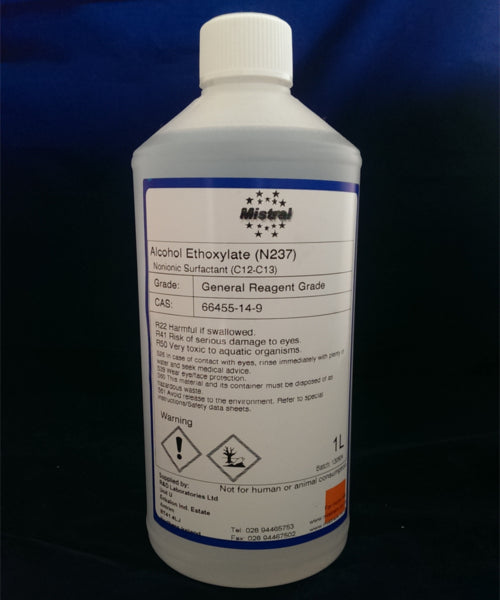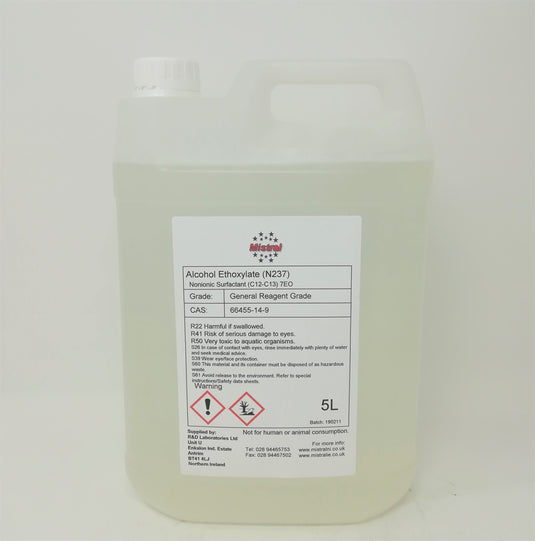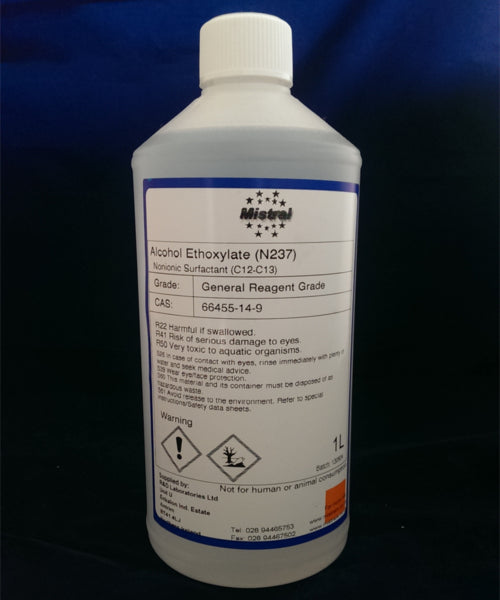

ALCOHOL C12-C13 ETHOXYLATE
Nonionic Surfactant (C12-C13) 7EO
Alcohol ethoxylates (AEs) are nonionic surfactants commonly used in a wide range of cleaning and industrial applications. They are produced by the ethoxylation of fatty alcohols, a process where ethylene oxide is added to the alcohol, creating a molecule with a hydrophobic (water-repellent) alcohol group and a hydrophilic (water-attracting) ethoxy group.
Their ability to break down grease and oils, work in hard water, and function as emulsifiers or wetting agents makes them essential ingredients in many industrial and household applications.
Key Properties:
- Chemical Structure: Alcohol ethoxylates consist of a fatty alcohol chain (derived from natural or synthetic sources) and one or more ethoxy groups (-CH₂CH₂O-), which are added to make the molecule more water-soluble.
- Molecular Formula: General formula is RO(CH₂CH₂O)nH, where R is the hydrophobic alkyl chain and n represents the number of ethoxy groups.
- Physical Form: Clear, colorless to pale yellow liquid or solid, depending on the ethoxylation degree (higher ethoxylation results in more water solubility).
- Nonionic Nature: As nonionic surfactants, AEs do not carry any charge, making them less sensitive to water hardness and other ions in solutions.
Common Uses:
1. Household and Industrial Cleaning Products:
- Detergents: Alcohol ethoxylates are widely used in laundry detergents, dishwashing liquids, and hard surface cleaners because of their excellent grease-cutting and stain-removing abilities. They break down oils and fats, making them easier to rinse away.
- Hard Surface Cleaners: They are used in industrial and household surface cleaners to remove dirt, grease, and oils from various surfaces like floors, counters, and appliances.
- Degreasers: In industrial applications, alcohol ethoxylates are incorporated into degreasing agents for cleaning equipment, engines, and metal parts. Their ability to emulsify oils and grease makes them effective in heavy-duty cleaning.
2. Textile Industry:
- Wetting Agents: In textile manufacturing, alcohol ethoxylates are used as wetting agents to improve the absorption of dyes and other finishing chemicals by the fabric. This helps ensure even distribution of colors and treatments.
- Detergents for Textile Processing: They are used in detergents for scouring and cleaning raw fibers, removing natural oils, and preparing textiles for further processing.
3. Agricultural Formulations:
- Emulsifiers in Pesticides and Herbicides: Alcohol ethoxylates are used in agricultural products to help emulsify active ingredients, allowing them to mix more effectively with water. This ensures better application and distribution of pesticides and herbicides on crops and soils.
- Spray Adjuvants: These surfactants enhance the wetting and spreading of agricultural chemicals on plant surfaces, increasing their effectiveness.
4. Oil and Gas Industry:
- Enhanced Oil Recovery: In oil extraction processes, alcohol ethoxylates are used as surfactants to help reduce surface tension between oil and water, improving the efficiency of oil recovery from underground reservoirs.
- Oilfield Chemicals: They are used in drilling fluids, emulsifiers, and demulsifiers to assist in oil and gas extraction and refining processes.
5. Cosmetics and Personal Care:
- Emulsifiers in Lotions and Creams: Alcohol ethoxylates can be found in some personal care products like creams and lotions as emulsifiers, helping to blend water and oil phases and stabilize the product.
- Mild Surfactants: While less common than in industrial applications, some alcohol ethoxylates are used in personal care products like shampoos and body washes for their mildness compared to anionic surfactants.
6. Paints, Coatings, and Adhesives:
- Emulsifiers and Dispersing Agents: Alcohol ethoxylates are used in the production of paints, coatings, and adhesives to help disperse pigments and ensure even application of the coating on surfaces.
Benefits of Alcohol Ethoxylates:
- Effective Surfactant: AEs are excellent at breaking down oils, greases, and soils, making them effective for both household and industrial cleaning tasks.
- Non-ionic Nature: As non-ionic surfactants, they work well in hard water conditions where ionic (charged) surfactants may lose effectiveness. This makes them suitable for a wide variety of environments and applications.
- Biodegradability: Many alcohol ethoxylates are readily biodegradable, which makes them more environmentally friendly compared to other synthetic surfactants, especially in applications where biodegradability is important.
- Versatile: The ability to customize the hydrophilic-lipophilic balance (HLB) by varying the length of the ethoxy chain allows alcohol ethoxylates to be tailored for different applications, from oil emulsification to water solubility.
CAS No. 160901-19-9 / 66455-14-9
Typical properties :
- Appearance at 25oC: Clear to hazy liquid
- Odour: Faint, Characteristic.
- Density at 20oC: approx 1.00 g/cm3
- Pour Point < 0oC
- Specific gravity <1
- Viscosity 23cPs
- Superior wetting
- Excellent oily soil removal
- Rapid dissolution and good rinsibility
- Low odour
- Excellent formulation and handling properties
- Readily biodegradable

